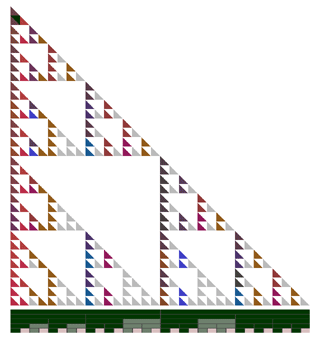| tone23 | ||||||||||
| home | background | description | Second Life | Croquet | music engine | theory | paper | future | personnel |
| Music Engine: Automatic Music Analysis and Creation | < music engine |
| Music Theory: Nested Repetition and Musical Counterpoint Groove-based music is largely based on looping musical structures. Musical transformations are applied to various degrees of repetition in order to produce rhythmic syncopation and harmonic variation. Repetition and variation are often nested within larger articulations of the metrical structure. This type of music is typically composed using software applications which allow a composer/producer to manage multiple levels of musical activity by looping, cutting, pasting, and transforming musical elements. The traditional rules of musical harmony and counterpoint are also concerned with multi-leveled musical structures: related transformations of deep-level musical structure give rise to unified musical surfaces. The work of music theorists such as Heinrich Schenker, Arthur Komar, Fred Lerdahl, and Ray Jackendoff provides frameworks for analyzing nested musical relationships. Groove-based composition can be (sometimes unconsciously) similar in practice to an inversion of a reductional, transformation-based musical analysis, Musical elements at one level are often triggered by, or woven into, musical material at a higher metrical level. Software applications used by composers enable the management of nested musical structure so that the composer is guided by ear towards musical results which would have required more conscious structural design in traditional music composition. This style of music is often characterized by relatively short note patterns in duple meter. The meter is clearly delineated by the drum parts, and this leaves the other parts free to provide syncopation and variation. The regularity of meter and the prevalence of nested repetition suggest that such music might best be analyzed in terms of regularly spaced, interlocking pulses. The problem then is how to relate the patterns produced by selective, nested repetition to the principles of harmonic and contrapuntal structure. The patterns formed by the distribution of binomial coefficients turn out to capture the most basic counterpoint rules for musical elaboration via syncopating and/or subdividing material at successive metrical levels. These patterns may be observed as rows of odd binomial coefficients on Pascal's Triangle, often visualized as a fractal known as the Sierpinski Gasket. The connection to the Sierpinski Gasket is a manifestation of the fact that patterns can be directly evolved from each other via a cellular automaton. |
|
 |
|
| Rhythmic/harmonic analysis of "Theme from 007" | |
| Rhythmic building blocks based on these patterns provide the music software environment with handles onto the hierarchical structure of music. The set of building blocks which constitute a particular piece provides a structural profile that can be compared and contrasted with other pieces. Harmonic and rhythmic operations can be carried out more efficiently and meaningfully on the building blocks than on the individual notes. Variations and hybrids of existing pieces are created by algorithms operating on the building blocks that comprise each piece. |
|
contact: info@tone23.org